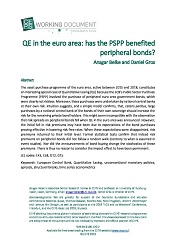QE in the euro area: has the PSPP benefited peripheral bonds?
QE in the euro area: has the PSPP benefited peripheral bonds?
Author(s): Ansgar Belke, Daniel Gros
Subject(s): Politics / Political Sciences, Politics, History, Economy, Recent History (1900 till today), Economic policy, Government/Political systems, Present Times (2010 - today), Financial Markets
Published by: CEPS Centre for European Policy Studies
Keywords: European Central Bank; Quantitative Easing; unconventional monetary policies; spreads, structural breaks; time series econometrics;
Summary/Abstract: The asset purchase programme of the euro area, active between 2015 and 2018, constitutes an interesting special case of Quantitative Easing (QE) because the ECB’s Public Sector Purchase Programme (PSPP) involved the purchase of peripheral euro area government bonds, which were clearly not riskless. Moreover, these purchases were undertaken by national central banks at their own risk. Intuition suggests, and a simple model confirms, that, ceteris paribus, large purchases by a national central bank of the bonds of their own sovereign should increase the risk for the remaining private bond holders. This might seem incompatible with the observationthat risk spreads on peripheral bonds fell when QE in the euro area was announced. However, the initial fall in risk premiums may have been due to expectations of the bond purchases proving effective in lowering risk-free rates. When these expectations were disappointed, risk premiums returned to their initial level. Formal statistical tests confirm that indeed risk premiums on peripheral bonds did not follow a random walk (contrary to what is assumed inevent studies). Nor did the announcements of bond buying change the stochastics of these premiums. There is thus no reason to consider the impact effect to have been permanent.
Series: CEPS Working Document
- Print-ISBN-13: 978-94-6138-720-2
- Page Count: 27
- Publication Year: 2019
- Language: English
- eBook-PDF
- Table of Content
- Introduction

